Providing structural support for drivable grass driveways, parking lots and roads.
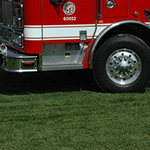
Structurally Strong
NDS grass pavers are built to withstand heavy vehicular traffic. With strengths up to 98,770 psf, NDS these pavers are well suited for both grass roads where heavy vehicles will travel frequently, as well as driveways and parking lots where vehicles may be parked for long periods of time.
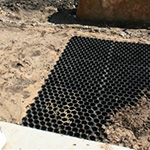
Simple Installation
Installation is designed to be easily accomplished by either a homeowner or landscape professional. NDS pavers are available in either roll or panel form, both of which can be attached to create a continuous surface of unlimited area.
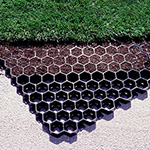
Sod or Seed
Grass pavers by NDS are compatible with both sod or seed grass installation. First, soil is placed in the cell membranes than seed is planted in the soil. If sod is desired, it can be simply laid over the soil filled membranes on top of the pavers.
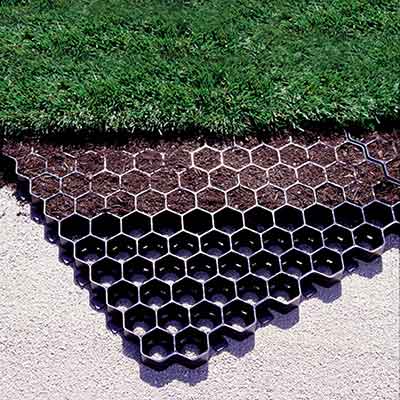
|
|
Grass Pavers for Driveways and Roads
|
Grass Paver Overview
With a variety of different applications, grass pavers (also known as "grass driveway pavers" allow for grassy areas to support constant vehicular traffic or parking without causing damage or rutting to the grass. The paver products are recommended for use in the following application types: fire lanes, event parking and overflow stadium, church parking, grass green driveway, utility access, on-street parking, pedestrians’ walkways, handicap parking, emergency access, infiltration basin reinforcement, golf cart paths, helicopter landing pads, airplane transport areas, service roads, roadway shoulder and equipment. It is also ideal for yards, truck maintenance, access road for emergency vehicle, overflow parking lots, jogging tracks, service roads, residential driveways, bike paths and the construction entrance of soil stabilization. Furthermore, this load application is also effective solution for swales and erosion control of slopes.
Grass pavers as well as
gravel pavers allow for instant rainfall permeability and can help reduce or eliminate the need for onsite drainage ponds which routinely cost developers thousands and are required when large paved areas are installed on properties in many regions.
Perfect for the homeowner as well, these pavers are frequently used to widen driveways in residential settings for parking of an extra car or boat.
Grass driveway pavers are available in a variety of different forms and are manufactured by a number of different manufacturers. Aside from the following options, another method of stabilizing soil for vehicular traffic is by using a cellular confinement panel. These products are flexible in design, constructed of a heavy-duty geotextile and can support heavy vehicles when filled with the correct type of infill.
Below are the three main types of pavers available:
Square Panel Pavers:
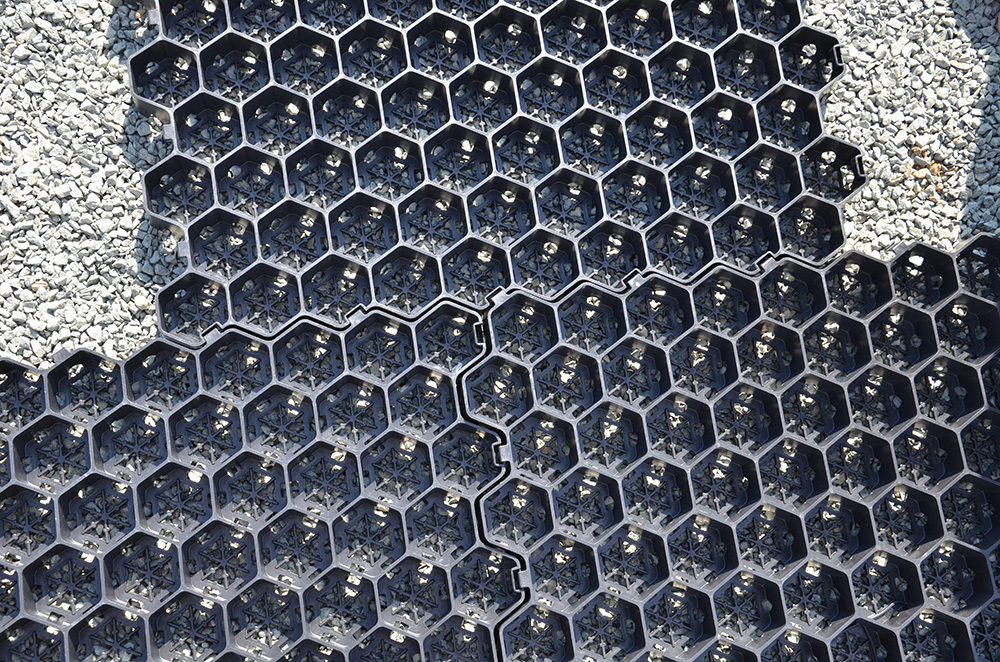
|
|
Three square 2' x 2' pavers connected together.
|
Square panel pavers are an ideal solution where the application calls for a paver which can withstand very heavy vehicles such as fire engines and semi trucks driving / parking over the reinforced area. Applications such as fire lanes or road shoulders often require the strength of these reinforced pavers to meet code and daily use requirements.
Square pavers are an ideal solution where the plan calls for a curved area such as a circular driveway or a windy road. The square pavers can be “stair-stepped” to accommodate the curves. The pavers can also be cut with a standard power saw to avoid obstacles such as curbs, sprinklers or other obstacles.
The square pavers are available in 19” x 19” squares or in 24” x 24” squares and interlock together to create a continuous surface. These pavers typically are 1-1/2” thick and can support approx.
97,000 pounds per square foot of pressure when empty. Once the pavers are filled they can withstand much more weight. In smaller quantities the square pavers are shipped via UPS, in larger orders the material typically ships via freight truck.
Installation of these pavers is fairly straight forward. A gravel sub base is applied to the site to provide stability. Next the gravel is compacted and a few inches of soil is placed above the gravel base. On top of the soil, the pavers are interlocked and placed. Once the pavers are placed the cells are filled with soil and seeded. If sod is to be applied it is rolled directly on top of the soil filled pavers. It is important that during the first growing season the area is watered more than usual to encourage strong grass growth.
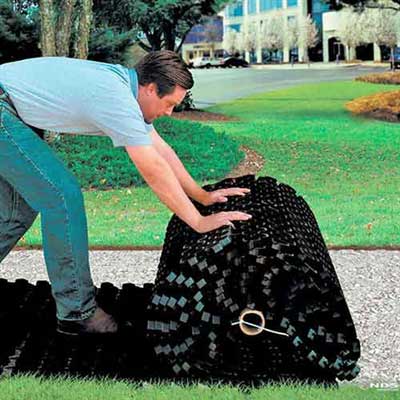
|
|
Rolled paver being unrolled over a layer of compacted aggregate.
|
Rolled Pavers
Rolled pavers are an excellent paver choice for large or small grassy areas which need to be reinforced. The rolled pavers are available in two sizes: 4' x 24' and 4' x 150'. The rolled pavers are as their name implied “rolled” and are installed by simply unrolling the product. The smaller rolls can be shipped via UPS while the larger rolls are shipped via freight truck due to their size. (Orders of the 4' x 24' rolls are shipped via UPS below quantities of 5, 5+ ship freight)
The rolled pavers can withstand approximately
57,000 pounds per square foot of pressure empty which greatly increases when the material is filled with soil. These pavers are ideal for installation types where there will not be large vehicles such as semi trucks for fire engines driving on the material.
Installation is a simple, straightforward process with rolled pavers. First, a gravel sub-base needs to be installed and compacted. This gravel base should consist of class 2 road base (3/4” crushed gravel) and compacted. The depth of the sub-base varies by application. See the specific product description for recommendations on the exact depth of the sub-base required. Once the sub-base is established, the material can be rolled directly on the base. Next, the cells are filled with soil and seeded. Optionally, sod can be rolled on top of the pavers. The grass roots will grow into the soil in the pavers and anchor into the gravel providing a reinforced and beautiful grass surface. It is important to irrigate the newly planted area heavily the first year to help establish a deep root zone for the grass.
Grass pavers are an excellent way to beautify an area which would otherwise be covered in cement, aid in stormwater management and avoid the costs and land devotion of drainage ditches. They are easy to install and are built to hold their strength with regular use. In either rolled or square form, the pavers are an excellent choice for both large and small projects in a variety of different installation settings. Alternatively, for a more economical, temporary and lower usage product view our selection of grass protection mesh.
If you have any questions about our paver products, sizing, installation information or requests for volume quotes please feel to contact us at (800) 524-4161.
How Grass Driveway Systems Work
A plastic grid
system sits on top of the soil or prepared substrate. Then it's filled with
soil, grass seed, or sod to create a strong surface for driving or parking
while still protecting the delicate root system of the grass so it can grow
naturally. The outcome looks like a lawn and can be taken care of with your
standard lawn equipment.
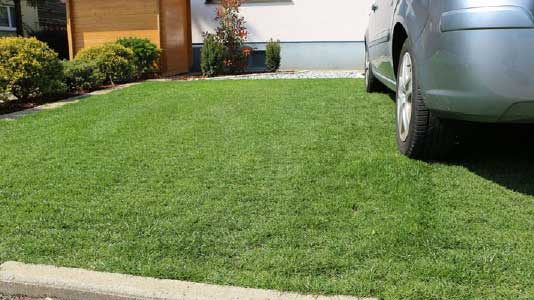
|
|
Grass Driveway Pavers Installed
|
A grass paver has many advantages over your basic parking surface and will
make your driveway, parking lot, or other pavement areas look both beautiful
and functional.
There is so much more to grass pavers than just
adding a touch of nature to your property. You have improved drainage and
erosion control while maintaining a low impact on the environment. These
pavers can be used to create a beautiful grass driveway, as a grass
stabilizer for your front lawn as well as your backyard. They can serve as a
ground stabilizer for mud control and for an added detention area below the
ground.
For many years, concrete and
asphalt were the only choices available for paved surfaces from driveways to
highways. Now you have grass pavers which are strong and are low in cost.
Homeowners have sworn by concrete for their driveways and sidewalks but
never realized there is a better alternative with incredible benefits. More
and more people are becoming environmentally conscious knowing some
traditions are meant to be broken.
One complaint many homeowners
have, there is no room for their gardens, space for their other vegetation,
and no room for their shrubbery to grow and fill out.
Studies have
shown that exposure to plants is very beneficial to your health and
well-being. Plants can improve your mind frame and are perfect for reducing
stress. Concrete and asphalt will prevent you from any of the benefits
you'll get from grass driveways. On top of that, concrete takes a good
amount of time to install while trying to create environmental areas for
your plants.
Plastic grass pavers are ready to use immediately after
installation and you can drive on them before the installation is even
completed. The problem with adding even more concrete takes away from the
joy of nature but grass pavers will let you keep vegetation and other
plants. Your grass can grow through the plastic pavers and you can cut the
grid to wrap around your trees and larger plants that cannot be replaced.
You will be saving living plants while adding more vegetation. There is no
need to destroy your beautiful oak tree!
Even though many people
still opt for concrete because it requires absolutely no maintenance but
what they have forgotten, concrete will stain over time from oil leaks from
their cars, dirt being dragged across the driveway, paint stains from arts
and crafts projects. You have to scrub and pressure wash the driveway which
is hard work and there are some stains that no matter what you do will not
come out unless you buy a special grease remover. Concrete can crack due to
the changing environment and weather conditions, root growth popping through
the surface, and don't forget ground movements.
Grass pavers are
environmentally friendly and allow stormwater to runoff and drain back into
the ground to naturally filter out pollutants and re-hydrate the earth and
vegetation. These paver systems offer a sub-base which is usually 3 to 6
inches deep that will detain water and offsets the negative effects of water
pooling. Let's face it after it rains the ground becomes saturated with
water and lawns become a muddy mess while tearing up the surrounding area.
In turn, it's difficult to get to your car due to this enormous obstacle.
Muddy lawns can become an absolute nightmare, but grass pavers will
stabilize the surface of your lawn even during major storms. These pavers
offer a layer of solid and level ground for grass to hold onto, flooding
will not cause as much damage as with concrete. The plastic grid system of
absorbent pavers prevents rutting and will maintain stability even during
the heaviest storms. Also, you have pets or other furry animals in your
yard, this system will keep them from getting down and dirty in the mud and
your dog won't stand a prayer at digging!
The installation of a
reinforced grass driveway is fairly straight forward. The plastic grids
interlock like modular building blocks and are placed on top of a sub-base
of 5/8” angular rock for support and it will stay in place. Depending on how
deep your sub-base is, you can get thousands of cubic gallons of added
detention space on your property.
Once the pavers have been laid
down, are interlocked, and filled, your pavement is ready to go. On the
other hand, often times, concrete must have a chemical process after its
poured, and that can take up to an entire week, depending on the weather.
To take care of your grass driveway, all you are required to do is cut
and water the grass just like you do your lawn. You might even discover you
will actually be watering less frequently. As water absorbs the surface,
surrounding plants will start drinking up the water which will reduce the
amount of water you will need. All this depends on how often and how much
rain you get in your area.
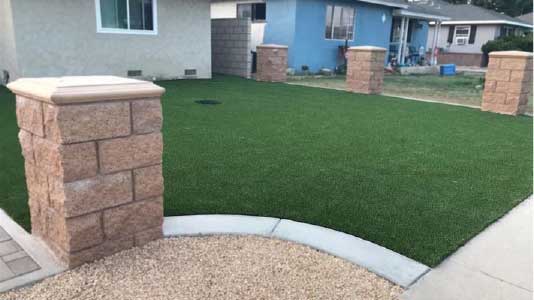
|
|
Grass Driveway Pavers Installed in Front Yard Parking
Area
|
How To Create A Grass Driveway
Before beginning be sure the location is safe to dig in. You should call your
utility service for needed information.
From the street grade level,
start digging down approximately 6 inches in the outlined area. This will depend
on the expected load and drainage needs. For drainage, spend a little time
figuring out the slope of the ground and how much detention area you want
underneath the grass paver system. Taking into consideration, the shorter
sub-base means less detention area to hold water.
Flatten the soil with a
tamper to make sure you have stability.
Now you need to create the
sub-base:
Depending on your expected load and drainage requirements, lay
down 3 to 6 inches of ¾ inch crushed stone, preferably absorbent stone such as
limestone or granite. Tamp down the layer with your tamper for a stable
foundation.
Start from the end of the driveway and start placing the grid
approximately an inch below street level. Cover the whole area with the grid and
snap the pieces together. Do Not cut any of the pieces so you can fit them into
odd shapes until after the grid is totally laid out.
After the grid is
totally connected and laid down, fill in the hollow space of the grid with loam
and smooth out with a push broom or a rake.
In order to fit the grid in
organically-shaped areas, outline the trim marks on the plastic paver to cut
with the saw on the machine. Attach it to the rest of the grid.
Once you
have completed all the previous steps, place down your choice of sod across the
grid. Be sure to refer to the official installation guide for the paver product
you are purchasing for specific installation guidance. If you decide you want
another type of grass, you can choose grass seed instead. Keep the area watered
until the grass starts to sprout.